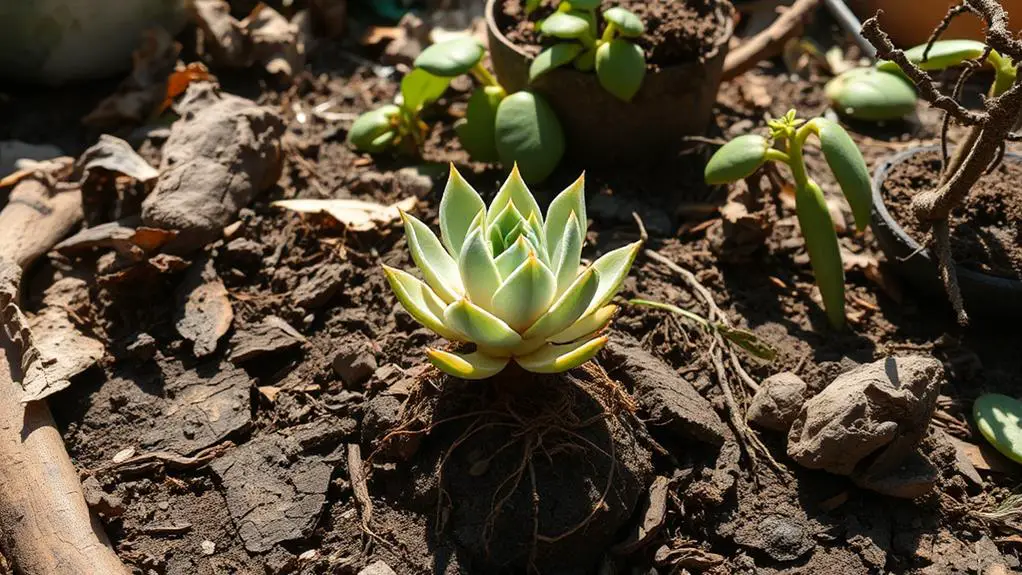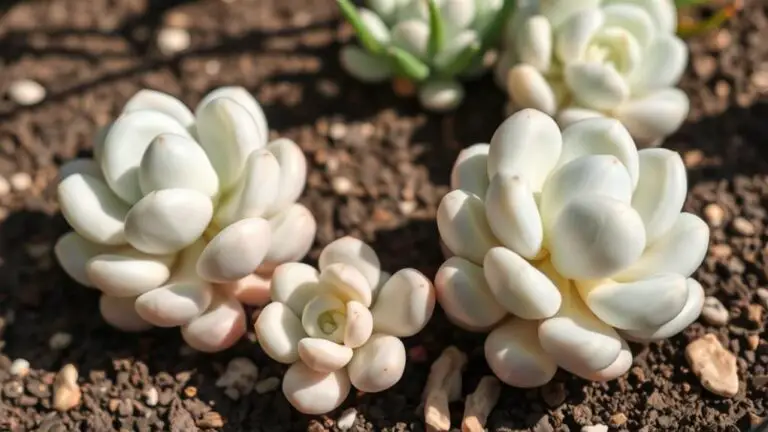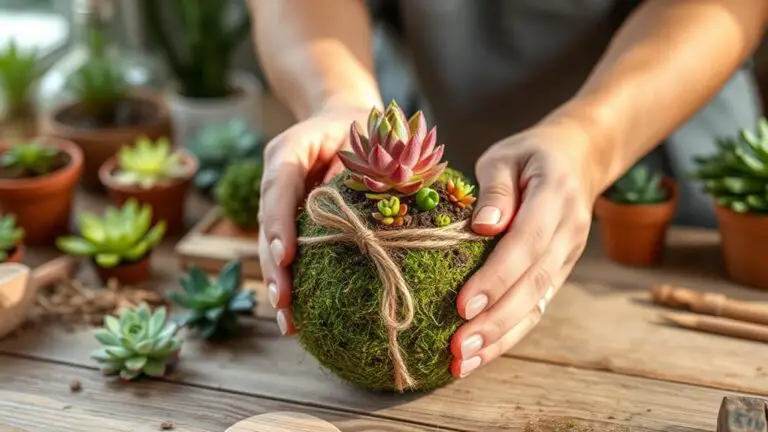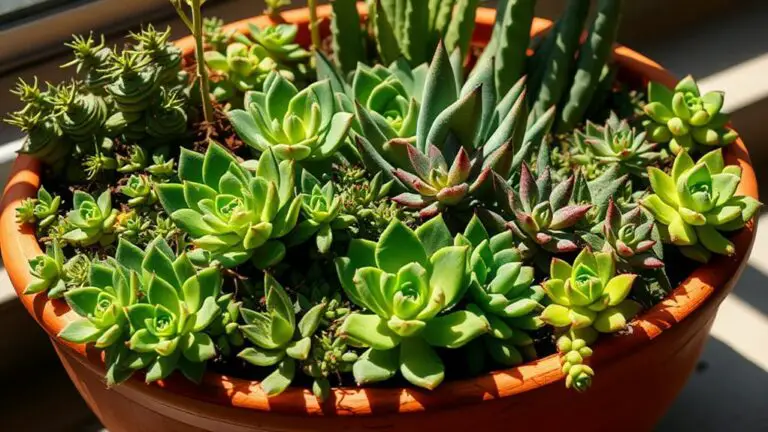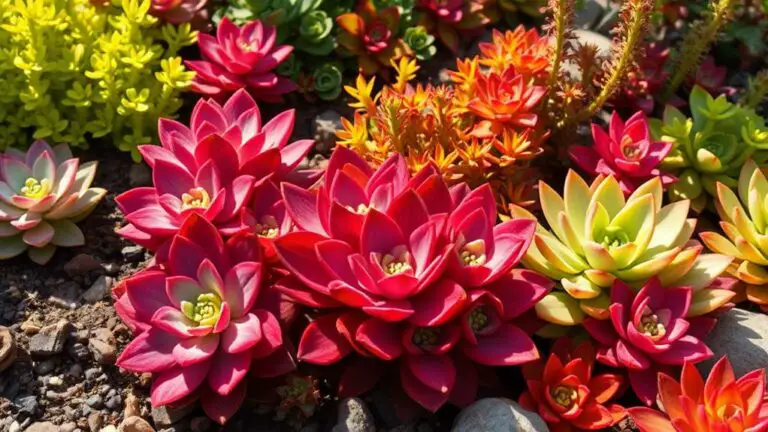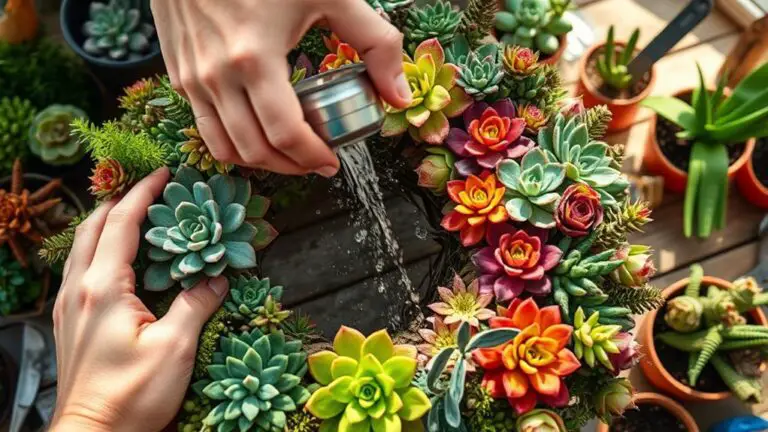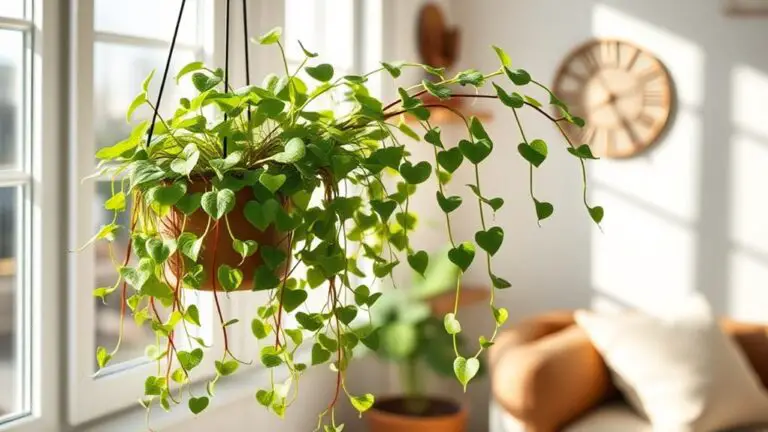7 Common Mistakes That Could Go Wrong in Your Succulent Propagation
When propagating succulents, it's easy to make mistakes that can derail your efforts. You might choose unsuitable varieties or mishandle leaf cuttings, causing them to fail. Overwatering is another frequent issue that leads to root rot and mushy leaves. Have you ever considered how inadequate light exposure could weaken your plants? Neglecting cleanliness can introduce harmful pathogens, and a disorganized workspace might be more problematic than you think. Each of these errors can greatly impact your success, so understanding them is vital. Ready to explore these pitfalls and guarantee thriving succulents?
Choosing Unsuitable Varieties
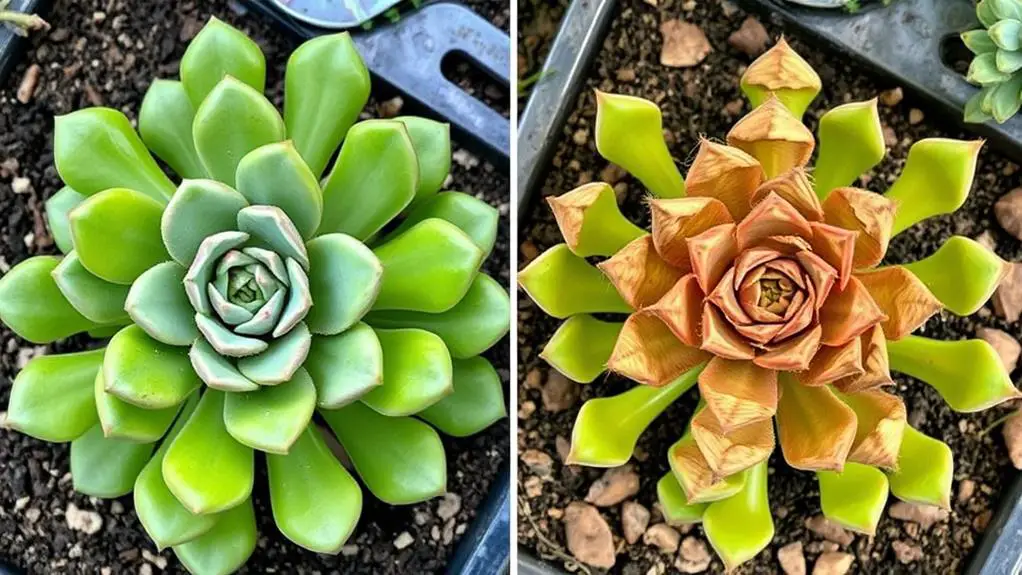
When it comes to propagating succulents, choosing the wrong varieties can be a major stumbling block. Some succulent varieties like Cotyledon, Aeonium, Senecio, Sempervivum, and thin-leaved Echeveria often lead to unsuccessful propagation attempts.
These varieties aren't suitable for leaf propagation. Instead, opt for Graptopetalum Purple Delight, Graptopetalum Amethystinum, or various sedums, which boast high success rates.
Select plump leaves from healthy plants to enhance root development. Look for healthy leaves near the plant's base, as these are ideal for cuttings.
Remember, your propagation efforts will be more successful when you choose the right variety. By avoiding unsuitable varieties, you'll increase your chances of growing vibrant, thriving succulents.
Happy propagating!
Mishandling Leaf Cuttings
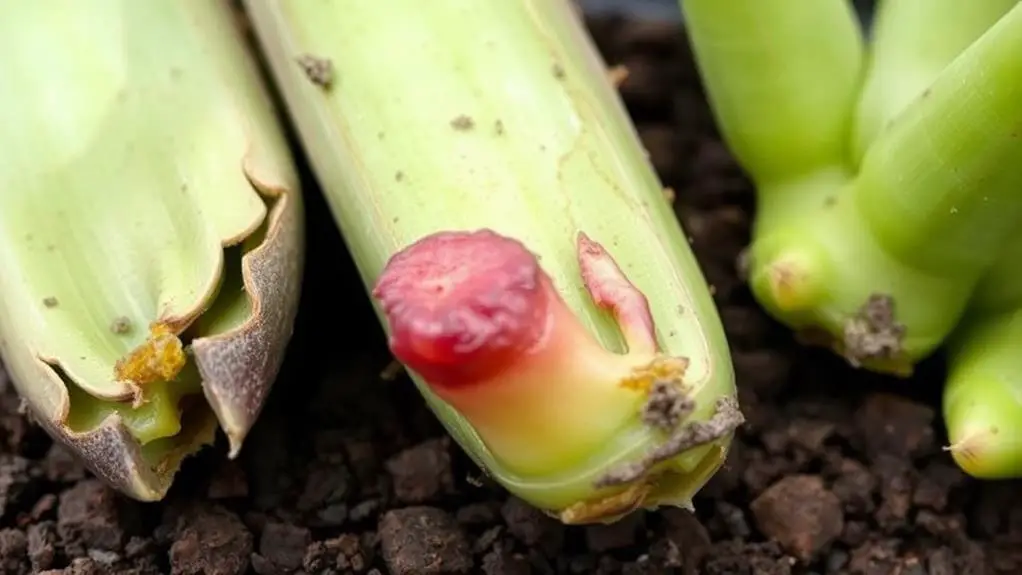
Mishandling leaf cuttings can drastically reduce your chances of successful succulent propagation. Start by gently twisting or wiggling leaves from the parent plant to avoid damaging growth points. Pick plump, healthy leaves near the base for higher success rates.
Allow the cut ends to air dry for 2-3 days before planting to prevent rot and promote healthy root development. Place your cuttings in well-draining soil and avoid watering until roots have formed; overwatering can lead to mushy leaves and decay.
Monitor light exposure carefully—insufficient light prevents roots from developing, while direct sunlight can scorch delicate leaves. By following these steps, you'll improve your chances of growing new succulents successfully.
Inadequate Drying Time
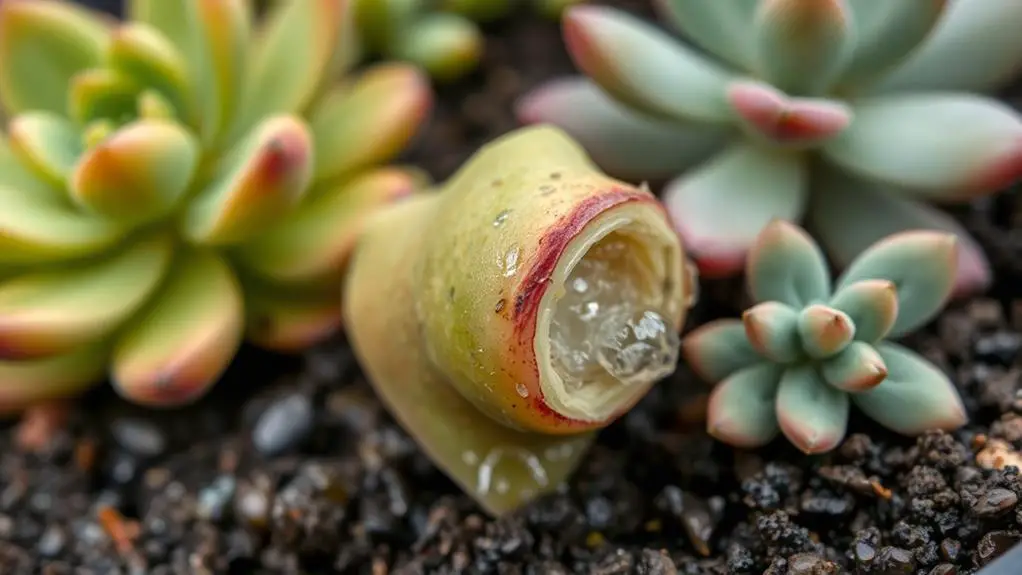
When you rush to plant succulent cuttings without letting them dry for 2-3 days, you risk open wounds that can easily get infected.
This can lead to mushy leaves and a higher chance of decay because moisture traps bacteria around the cuts.
Being patient and allowing proper drying time helps prevent these issues, ensuring your plantlets start off strong and healthy.
Risks of Premature Planting
Planting succulent cuttings too early is a common mistake that can lead to disastrous results. Premature planting before the cutting edges have time to callous and dry invites moisture and pathogens, causing mushy leaves instead of healthy roots. The drying time is essential; it allows the cuttings to heal and form a protective barrier. Insufficient drying means the plant focuses on healing rather than root development. Patience is key to avoid these pitfalls.
| Issue | Cause | Effect |
|---|---|---|
| Premature planting | Lack of adequate drying time | Rot due to moisture and pathogens |
| Soft, mushy leaves | Excess moisture absorption | Decay instead of root formation |
| Delayed root growth | Focus on healing, not rooting | Slowed overall development |
| Infection risk | Uncalloused cutting edges | Vulnerability to pathogens |
| Long-term health | Insufficient root development | Weak, unhealthy plants |
Infection and Decay Prevention
Ensuring proper drying time for succulent cuttings is essential to prevent infection and decay. When you cut a succulent, allow the ends to air dry for 2-3 days. This forms a callous, protecting the cutting from bacterial and fungal infections that cause rot.
Rushing this step can lead to propagation failure, as moist environments can easily compromise inadequately dried cuttings. Make sure to regularly inspect your cuttings for any signs of infection or decay during this period.
Essential Patience Practices
Taking the time to let your succulent cuttings dry properly is vital for their success in propagation. When you propagate succulents, allowing the leaves to dry for 2-3 days prevents rot and infection. This drying time helps form a callous over the cut surface, essential for healthy root development.
If you rush this step, the open wounds on the leaves can absorb excess moisture, leading to mushiness and decay.
Patience is key to avoiding common succulent propagation mistakes. Remember, succulents absorb moisture through their leaves, so adequate drying time guarantees stronger root growth and higher propagation success rates.
Using Incorrect Methods
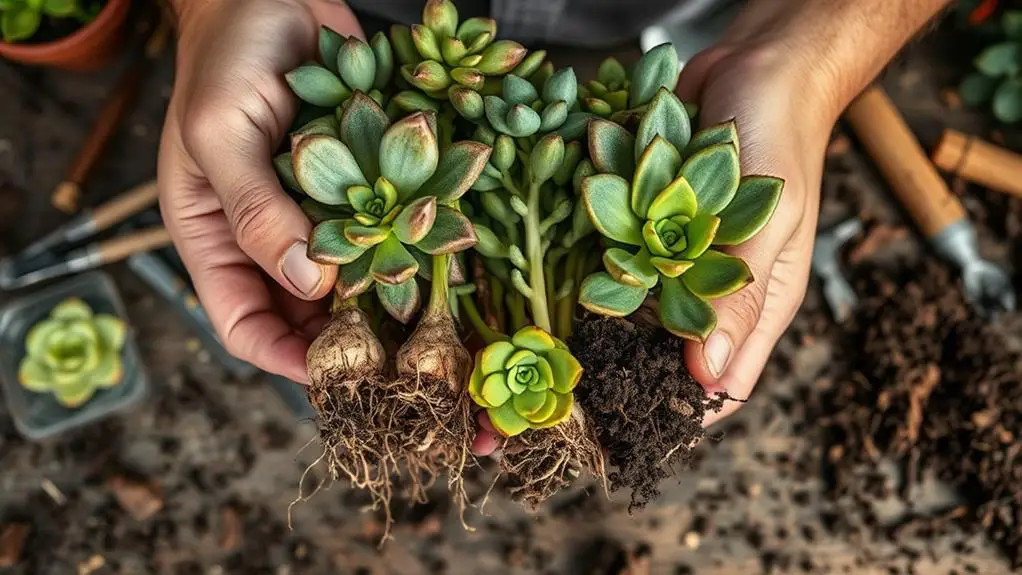
Many succulent enthusiasts unknowingly jeopardize their propagation efforts by using incorrect methods.
Ensuring successful propagation means avoiding several common pitfalls:
- Using water propagation for succulents like Echeveria or Sempervivum can lead to root rot.
- Cutting from unhealthy parent plants increases the risk of disease transmission to new cuttings.
- Not letting cut ends callous before planting in soil causes excessive moisture absorption and rot.
- Overcrowding cuttings in one container leads to competition for resources, hindering growth and spreading disease.
- Failing to research specific propagation requirements for different varieties often results in poor outcomes.
Overwatering Cuttings
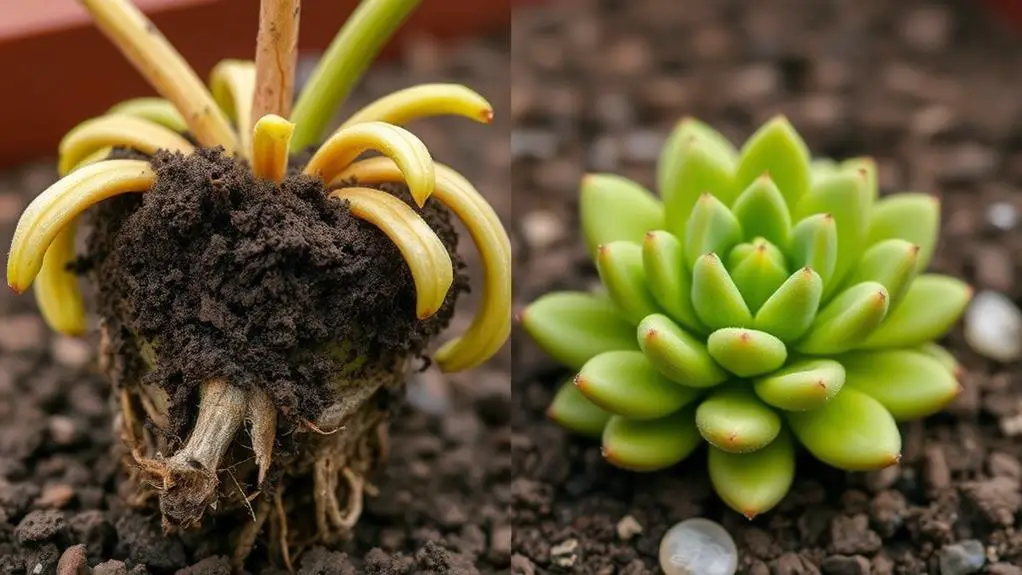
While using incorrect methods can jeopardize your succulent propagation efforts, overwatering cuttings is another critical mistake to avoid. Too much moisture can lead to root rot and mushy leaves in your succulents. Let your cuttings dry out completely before watering them. This helps the roots establish first. Squishy or yellowing leaves? That's a sign of overwatering.
Use well-draining soil and containers to prevent this issue. Monitor the soil moisture levels and only water when it's completely dry. This guarantees successful propagation.
Here's a useful table to remember:
| Mistake | Solution |
|---|---|
| Overwatering | Let cuttings dry out |
| Root rot | Use well-draining soil |
| Squishy leaves | Monitor soil moisture levels |
| Yellowing leaves | Only water when soil is dry |
| Excess moisture | Use well-draining containers |
Improper Light Exposure
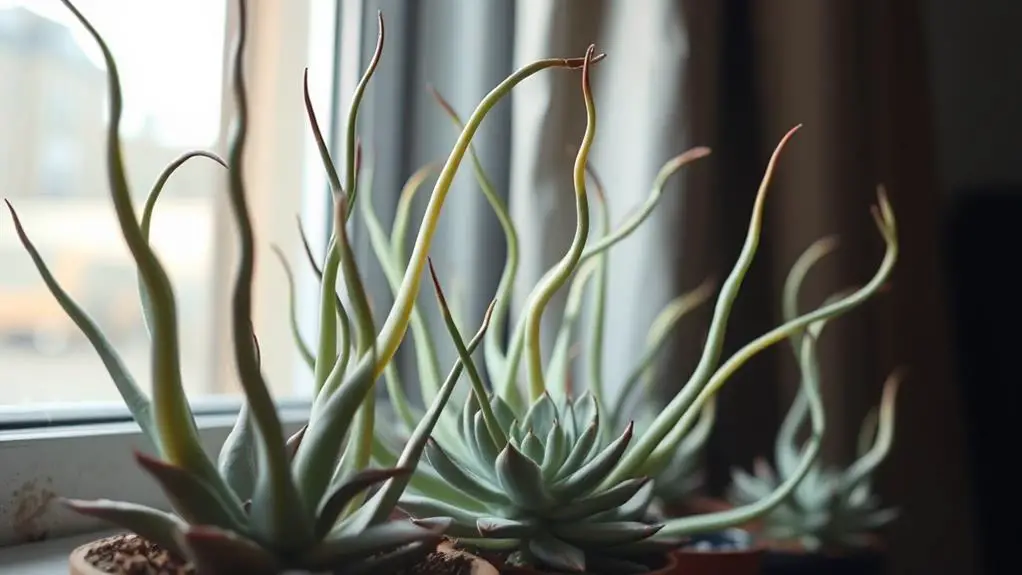
Bright sunlight can be both a friend and foe to your succulents. During propagation, improper light exposure can make or break your efforts.
Too little light can lead to etiolation, where succulents stretch unnaturally, becoming weak. On the other hand, direct sunlight can cause leaf burn and dehydration, hindering rooting.
For ideal results, aim for bright, indirect sunlight. This promotes photosynthesis without damaging leaves.
Here's what to keep in mind:
- Avoid direct sunlight to prevent leaf burn.
- Guarantee consistent light exposure, about 12-16 hours a day.
- Use grow lights if natural light is insufficient.
- Watch for signs of etiolation and adjust lighting as needed.
- Adequate light helps succulents generate energy for successful rooting.
These tips will increase your success rate in succulent propagation!
Ignoring Cleanliness
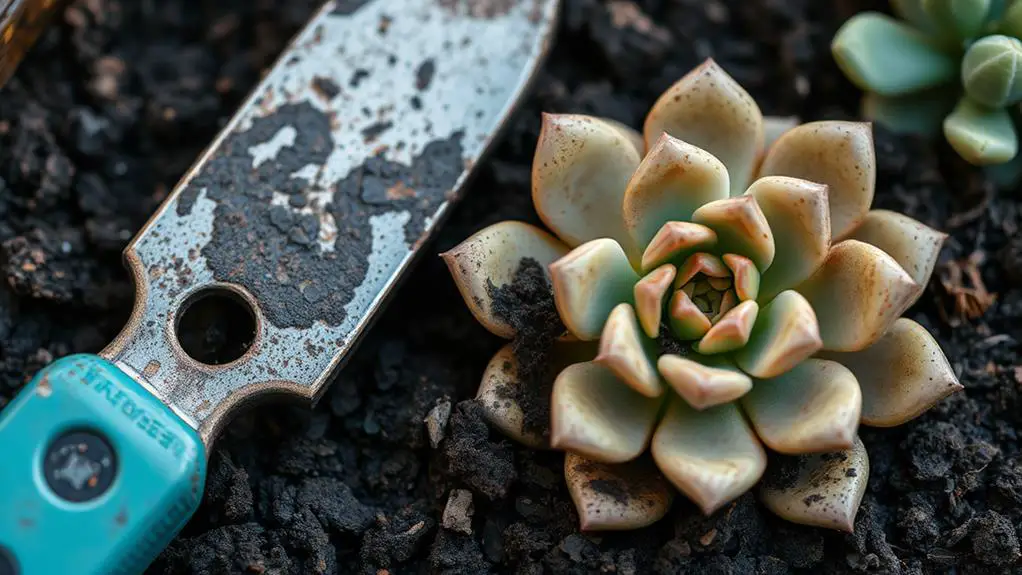
Ensuring proper light exposure is only part of the equation; cleanliness can't be ignored if you want your succulent propagation to succeed. Using unclean tools introduces harmful pathogens, leading to diseases and propagation failure. Always sterilize your tools. Don't forget cleaning leaves and cut surfaces to avoid pest infestations and infection. Touching cut surfaces with bare hands transfers oils and bacteria, compromising cuttings. Keep your working environment clean to prevent cross-contamination between plant species. Regularly inspect your propagation area for pests and diseases. Neglecting cleanliness can lead to severe issues affecting all your plants.
| Mistake | Consequence | Solution |
|---|---|---|
| Unclean tools | Diseases, rot | Sterilize tools |
| Dirty leaves/cuttings | Pest infestations | Clean leaves and cuttings |
| Bare hands on cuts | Increased decay | Use clean gloves |
| Messy work area | Cross-contamination | Keep area tidy |
| Ignoring inspections | Spread of issues | Regular checks |
Frequently Asked Questions
Why Are My Succulent Propagations Dying?
Your succulent propagations might be dying due to overwatering, insufficient light, or using unhealthy parent leaves. Verify cut ends callous before planting and avoid crowding the cuttings. These steps will help improve your success rate.
What Is One of the Most Common Mistakes in Plant Propagation?
One of the most common mistakes in plant propagation is overwatering. You'll want to avoid this because succulents are especially prone to rot from too much moisture. Let the soil dry out completely between waterings to guarantee success.
Why Is My Succulent Stem Cutting Not Rooting?
Your succulent stem cutting isn't rooting likely because it's not getting enough bright, indirect light or you're overwatering it. Make sure you let the cut ends callous and use well-draining cactus soil to prevent rot.
What Are the Conditions for Succulents to Propagate?
You need well-draining soil, slightly acidic to neutral pH, bright indirect sunlight, temperatures between 60°F and 80°F, low humidity, and let cuttings callous for 2-3 days before planting to successfully propagate succulents.
Conclusion
You've got the tools and knowledge now to avoid common mistakes in succulent propagation. Remember to choose the right varieties, handle cuttings gently, and give them adequate drying time. Use the correct methods, avoid overwatering, and guarantee they get enough light. Keep your workspace clean and inspect your plants regularly. With these tips, you can grow healthy, thriving succulents. Don't worry—everyone makes mistakes, but learning from them makes you a better gardener!

